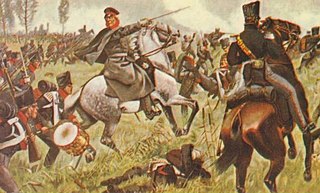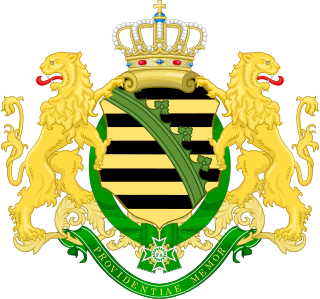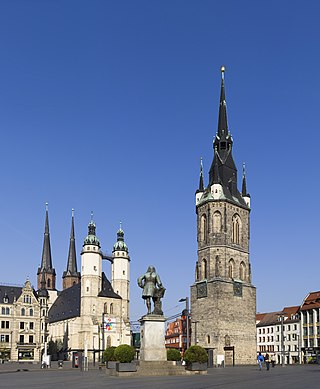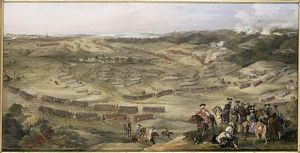
The Battle of Dettingen took place on 27 June 1743 during the War of the Austrian Succession at Dettingen in the Electorate of Mainz, Holy Roman Empire. It was fought between a Pragmatic Army, composed of the British, Hanoverian and Austrian troops, and a French army commanded by the duc de Noailles.

The Battle of Rossbach took place on 5 November 1757 during the Third Silesian War near the village of Rossbach (Roßbach), in the Electorate of Saxony. It is sometimes called the Battle of, or at, Reichardtswerben, after a different nearby town. In this 90-minute battle, Frederick the Great, king of Prussia, defeated an Allied army composed of French forces augmented by a contingent of the Reichsarmee of the Holy Roman Empire. The French and Imperial army included 41,110 men, opposing a considerably smaller Prussian force of 22,000. Despite overwhelming odds, Frederick employed rapid movement, a flanking maneuver and oblique order to achieve complete surprise.

George V was the last King of Hanover, the only child and successor of King Ernest Augustus. George V's reign was ended by the Austro-Prussian War, after which Prussia annexed Hanover.

The Battle of Breslau was a battle fought on 22 November 1757 in Breslau during the Third Silesian War. A Prussian army of 28,000 men fought an Austrian army of 84,000 men. The Prussians held off the Austrian attack, losing 6,000 men to the Austrians 5,000 men. But one day later the Prussians beat a retreat. Breslau's garrison surrendered on 25 November 1757.

The Battle of Leuthen was fought on 5 December 1757 and involved Frederick the Great's Prussian Army using maneuver warfare and terrain to rout a larger Austrian force completely, which was commanded by Prince Charles of Lorraine and Count Leopold Joseph von Daun. The victory ensured Prussian control of Silesia during the Third Silesian War, which was part of the Seven Years' War.

The Battle of Minden was a major engagement during the Seven Years' War, fought on 1 August 1759. An Anglo-German army under the overall command of Prussian Field Marshal Ferdinand of Brunswick defeated a French army commanded by Marshal of France, Marquis de Contades. Two years previously, the French had launched a successful invasion of Hanover and attempted to impose an unpopular treaty of peace upon the allied nations of Britain, Hanover and Prussia. After a Prussian victory at Rossbach, and under pressure from Frederick the Great and William Pitt, King George II disavowed the treaty. In 1758, the allies launched a counter-offensive against the French and Saxon forces and drove them back across the Rhine.

Louis Charles César Le Tellier, Duke d'Estrées was a French military commander and Marshal of France.

The Electorate of Hanover was an electorate of the Holy Roman Empire, located in northwestern Germany and taking its name from the capital city of Hanover. It was formally known as the Electorate of Brunswick-Lüneburg. For most of its existence, the electorate was ruled in personal union with Great Britain and Ireland following the Hanoverian Succession.

Ferdinand, Prince of Brunswick-Lüneburg, was a German-Prussian field marshal (1758–1766) known for his participation in the Seven Years' War. From 1757 to 1762 he led an Anglo-German army in Western Germany which successfully repelled French attempts to occupy Hanover.

The Battle of Wartenburg took place on 3 October 1813 between the French IV Corps commanded by General Henri Gatien Bertrand and the Allied Army of Silesia, principally the I Corps of General Ludwig von Yorck. The battle allowed the Army of Silesia to cross the Elbe, ultimately leading to the Battle of Leipzig.

The Royal Saxon Army was the military force of the Electorate (1682–1807) and later the Kingdom of Saxony (1807–1918). A regular Saxon army was first established in 1682 and it continued to exist until the abolition of the German monarchies in 1918. With the formation of the Confederation of the Rhine by Napoleon the Royal Saxon Army joined the French "Grande Armée" along with 37 other German states.

The Battle of Corbach, or Korbach, a Hanseatic town of Waldeck-Frankenberg in northern Hesse, Germany, was fought on 10 July 1760 during the Seven Years' War. Corbach was the first battle of the campaign of 1760 and was a victory for the French over the Hanoverians, the British and their allies.

The Invasion of Hanover took place in 1757 during the Seven Years' War when a French army under Louis Charles César Le Tellier, duc d'Estrées advanced into the Electorate of Hanover and neighbouring German states following the Battle of Hastenbeck. French forces overran most of Hanover forcing the Hanoverian Army of Observation, intended to defend the Electorate, to Stade on the North Sea coast. At the Convention of Klosterzeven the Duke of Cumberland agreed to disband his army and acknowledge the French occupation of the Electorate.

In the Battle of Halle on 17 October 1806 a French corps led by Jean-Baptiste Bernadotte fought the Prussian Reserve under Eugene Frederick Henry, Duke of Württemberg. The French defeated their opponents, forcing the Prussians to retreat northeast toward Dessau after suffering heavy losses. The clash occurred in the War of the Fourth Coalition, part of the Napoleonic Wars. The city of Halle is located about 30 kilometers northwest of Leipzig on the Saale River.

Ernst von Rüchel was a Prussian general who led an army corps in a crushing defeat by Napoleon at the Battle of Jena on 14 October 1806. He commanded troops from the Kingdom of Prussia in several battles during the French Revolutionary Wars in 1793 and 1794. Afterward he held various appointments as a diplomat and a military inspector. In 1806 during the Napoleonic Wars he held an important army command but has been criticized for his actions at Jena. Wounded, he managed to escape the French pursuit, but never commanded troops in combat again.

In the siege of Hamelin or siege of Hameln, First French Empire forces captured the fortress of Hamelin from its garrison composed of troops from the Kingdom of Prussia. The siege was begun by the VIII Corps under French Marshal Édouard Adolphe Casimir Joseph Mortier. The marshal initially left General of Division Jean-Baptiste Dumonceau in charge of operations. General of Division Anne Jean Marie René Savary soon arrived to conduct negotiations with the Prussian commander General Karl Ludwig von Lecoq, who was quickly persuaded to surrender. Technically, the operation from the War of the Fourth Coalition was a blockade because a formal siege never took place. Hamelin is located 36 kilometers southwest of Hanover.
Karl Ludwig von Lecoq or Karl Ludwig von Le Coq, born 23 September 1754 – died 14 February 1829, of French Huguenot ancestry, first joined the army of the Electorate of Saxony. He later transferred his loyalty to the Kingdom of Prussia and fought during the French Revolutionary Wars, earning a coveted award for bravery. While serving variously as a staff officer and diplomat, he became renowned as an expert cartographer. In 1806 he was entrusted with command of the forces in northwest Germany. Cut off from the main body of the Prussian army after the disaster at the Battle of Jena-Auerstedt, he concentrated his troops in the fortress of Hameln. After a brief siege, he surrendered his troops to an inferior force of enemies. For this, he was sentenced to life imprisonment. However, he was later pardoned and continued his map-making until he went blind.
The VIII Corps of the Grande Armée was a French military unit that existed during the Napoleonic Wars. Emperor Napoleon I formed it in 1805 by borrowing divisions from other corps and assigned it to Marshal Édouard Mortier. Marshal André Masséna's Army of Italy was also reorganized as the VIII Corps at the end of the 1805 campaign. The corps was reformed for the 1806 campaign under Mortier and spent the rest of the year mopping up Prussian garrisons in western Germany.

The siege of Ypres saw a Republican French army commanded by Jean-Charles Pichegru invest the fortress of Ypres and its 7,000-man garrison composed of Habsburg Austrians under Paul von Salis and Hessians led by Heinrich von Borcke and Georg von Lengerke. French troops under Joseph Souham fended off three relief attempts by the corps of François Sébastien Charles Joseph de Croix, Count of Clerfayt. Meanwhile, the French besiegers led by Jean Victor Marie Moreau compelled the Coalition defenders to surrender the city. The fighting occurred during the War of the First Coalition, part of the Wars of the French Revolution. In 1794 Ypres was part of the Austrian Netherlands, but today it is a municipality in Belgium, located about 120 kilometres (75 mi) west of Brussels.
The Hanover Expedition, also known as the Weser Expedition, was a British invasion of the Electorate of Hanover during the Napoleonic Wars. Coordinated as part of an attack on France by the nations of the Third Coalition against Napoleon by William Pitt the Younger and Lord Castlereagh, planning began for an invasion of French territories in July 1805. Hanover, previously a British possession, was chosen as the goal of the expedition, with Swedish and Russian forces under Gustav IV Adolf and Alexander Ivanovich Ostermann-Tolstoy brought in to support the endeavour. Key to the success of the invasion was the support of Prussia, a nation poised to threaten France but not as yet openly hostile to the country. Sir George Don commanded the British expedition and he arrived with an army of around 14,000 men at Cuxhaven in November. To bolster the expedition and to strengthen the resolve of Prussia, Don's army was reinforced by 12,000, with Lord Cathcart taking over command.



















